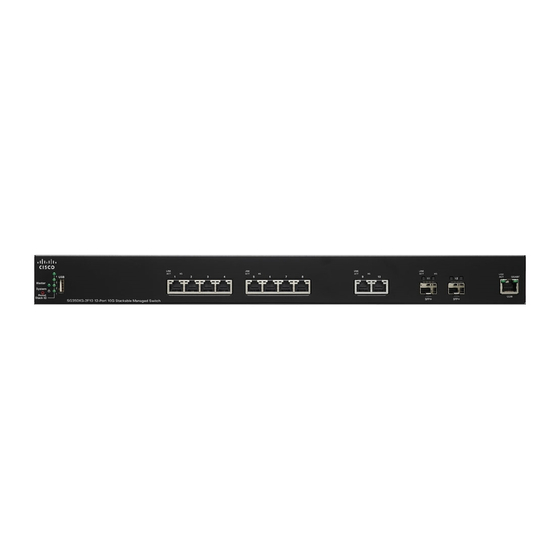Table of Contents
Advertisement
Advertisement
Table of Contents

Subscribe to Our Youtube Channel
Summary of Contents for Cisco SG350XG-2F10
-
Page 1: Quick Start Guide
Quick Start Guide Cisco 350XG Series 10G Stackable Managed Switches... -
Page 2: Before You Begin
Welcome Thank you for choosing the Cisco 350XG Series 10G Stackable Managed Switch, a Cisco network communications device. This device is designed to be operational right out-of-the-box as a standard layer 2 and 3 switch. In the default configuration, it will forward packets between connecting devices after power up. -
Page 3: Mounting The Cisco 350Xg Switches
For stability, load the rack from the bottom to the top, with the AUTION heaviest devices on the bottom. A top-heavy rack is likely to be unstable and might tip over. Cisco 350XG Series 1OG Stackable Switches Quick Start Guide... -
Page 4: Connecting Network Devices
Cisco 350XG Switches Features for details about the different ports and LEDs on each switch. Repeat Step 1 Step 2 for each device that you want to connect to the switch. Cisco 350XG Series 1OG Stackable Switches Quick Start Guide... -
Page 5: Configuring The Cisco 350Xg Switches
You must enter the new IP address that the switch is using into your browser to use the web-based interface. If you are managing the switch through a console port connection, the link is retained. Cisco 350XG Series 1OG Stackable Switches Quick Start Guide... - Page 6 When the login page appears, choose the language that you prefer to use in the web-based interface and enter the username and password. The default username is cisco. The default password is cisco. Usernames and passwords are both case sensitive. Click Log In.
-
Page 7: Configuring Your Switch Using The Console Port
Save icon. Exiting before you save your configuration will result in all changes being lost. The Getting Started page opens. You are now ready to configure the switch. Refer to the Cisco 350XG Series 10G Stackable Managed Switches Administration Guide or see the help pages for further information. - Page 8 Make sure that any configuration changes made are saved AUTION before exiting. You are now ready to configure the switch. Refer to the Cisco 350XG Series 10G Stackable Managed Switches Command Line Interface Reference Guide for further information. If you are not using DHCP on your network, set the IP address type on the switch to Static and change the static IP address and subnet mask to match your network topology.
-
Page 9: Cisco 350Xg Switches Features
SYSLOG files through the connected USB device. RJ-45 Ethernet Ports—The RJ-45 Ethernet ports connect network devices, such as computers, printers, and access points, to the switch. Cisco 350XG Series 1OG Stackable Switches Quick Start Guide... - Page 10 • The SFP+ ports are compatible with Cisco modules MGBSX1, MGBLH1, MGBT1, MGBLX1, MGBBX1, as well as other brands of modules. • The Cisco SFP+ 10G optical modules that are supported in the Cisco 350XG switches are: SFP-10G-SR, SFP-10G-LRM, and SFP-10G-LR.
-
Page 11: Back Panel
– Disconnect the switch from the network or disable all DHCP servers on your network. – With the power on, press and hold the Reset button for more than ten seconds. Cisco 350XG Series 1OG Stackable Switches Quick Start Guide... - Page 12 System LED provides an indication of where the switch received the IP address (See Front Panel for details.) Make sure that no other device is using the same IP address as the switch. Cisco 350XG Series 1OG Stackable Switches Quick Start Guide...
- Page 13 Unusually long access time: Due to the standard spanning tree loop detection logic, adding new connections may take 30 to 60 seconds for the affected interfaces and/or LAN to become operational. Cisco 350XG Series 1OG Stackable Switches Quick Start Guide...
-
Page 14: Where To Go From Here
Warranty Information www.cisco-warrantyfinder.com This is a class A product. In a domestic environment this ARNING product may cause radio interference in which case the user may be required to take adequate measures. Cisco 350XG Series 1OG Stackable Switches Quick Start Guide... - Page 15 Cisco 350XG Series 1OG Stackable Switches Quick Start Guide...
- Page 16 Cisco and the Cisco logo are trademarks or registered trademarks of Cisco and/or its affiliates in the U.S. and other countries. To view a list of Cisco trademarks, go to this URL: www.cisco.com/go/trademarks. Third-party trademarks mentioned are the property of their respective owners.

















Need help?
Do you have a question about the SG350XG-2F10 and is the answer not in the manual?
Questions and answers